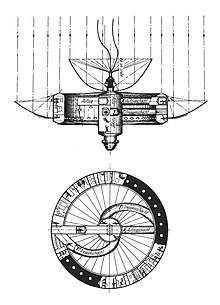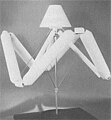Rotating wheel space station

A rotating wheel space station is a hypothetical wheel-shaped space station that could create artificial gravity by rotating. If the station were rotated, inertia and the centripetal force would cause objects to press against the outer rim of the "wheel"; in the rotating frame of reference of the space station centrifugal force would give an acceleration similar to gravity.
History
Both scientists and science fiction writers have thought about this concept since the beginning of the 20th Century. Konstantin Tsiolkovsky wrote about using rotation to create an artificial gravity in space in 1903. Herman Potočnik introduced a spinning wheel station with a 30 meter diameter in his Problem der Befahrung des Weltraums (The Problem of Space Faring). He even suggested it be placed in a geostationary orbit.
In the 1950s, Wernher von Braun and Willy Ley, writing in Colliers Magazine, updated the idea, in part as a way to stage spacecraft headed for Mars. They envisioned a rotating wheel with a diameter of 76 meters (250 feet). The 3-deck wheel would revolve at 3 RPM to provide artificial one-third gravity. It was envisaged as having a crew of 80.[1]
In 1959, a NASA committee opined that a such a space station was the next logical step after the Mercury program.[2] The Stanford torus, proposed by NASA in 1975, is an enormous version of the same concept, that could harbor an entire city.
NASA has never attempted to build a rotating wheel space station, for several reasons. First, such a station would be very difficult to construct, given the limited lifting capability available to the United States and other spacefaring nations. Assembling such a station and pressurizing it would present formidable obstacles, which, though not beyond NASA's technical capability, would be beyond available budgets. Second, NASA considers the present space station, the ISS, to be valuable as a zero gravity laboratory, and its current microgravity environment was a conscious choice.[3]
Gallery
-
A NASA engineer takes a walk in simulated zero gravity around a mock-up of a full-scale, 7.3 m (24 ft) diameter space station in 1964.
-
Proposed Nautilus-X International space station centrifuge demo
-
Rotating wheel space station.Werner von Braun 1952 concept.
-
Hexagonal inflatable rotating space station.1962 Nasa concept
-
Deployment of an hexagonal inflatable rotating space station.1962 Nasa concept.
-
Stanford torus, 1975 Nasa concept.
In fiction
A famous fictional space station of this kind is Space Station V, which appears in the film 2001: A Space Odyssey. The Japanese anime Planetes has its main set in "The Seven", the 7th wheel orbital station, while the 9th is under construction by 2075.
Two other examples of this type of space station are in the re-imagined series Battlestar Galactica. Ragnar Anchorage is a three ringed weapons storage station, and the civilian ship Zephyr is a luxury liner featuring a ringed midsection. In the Zenon trilogy (Zenon: Girl of the 21st Century, Zenon: The Zequel and Zenon: Z3), 13 year old Zenon lives on a rotating space station owned by the fictional WyndComm from 2049 though 2054 that is similar in appearance to Space Station V, but it is not designed in a way that would allow for artificial gravity through centripetal force like Space Station V of Space Odyssey 2001.
See also
- Man Will Conquer Space Soon!
- O'Neill Cylinder
- Space colonization
- Space stations and habitats in popular culture
- Space habitat
- Stanford torus
- Weightlessness
References
- ^ Ryan, Cornelius (editor; also associate editor of Collier’s magazine—it is stated on the dust jacket flap that half of the contents of the book initially appeared in the Collier’s magazine series of articles “Man Will Conquer Space Soon!”) Across the Space Frontier New York: September 1952, Viking Press. See Chapter 4 by Willy Ley--"A Station in Space" Pages 98-117; frontispiece of book has Chesley Bonestell illustration of entire wheel space station in orbit above Central America; pages 106 and 107 has cutaway illustration of interior of wheel space station; page 100 mentions that it is designed for a crew of 80. In the introduction on page xii it is mentioned that the rotating wheel space station will orbit 1,075 miles above Earth and will cost $4,000,000,000 in 1952 dollars.
- ^ Space station
- ^ "Home, Sweet Home". NASA. 25 May 2001. Archived from the original on 29 September 2006.







